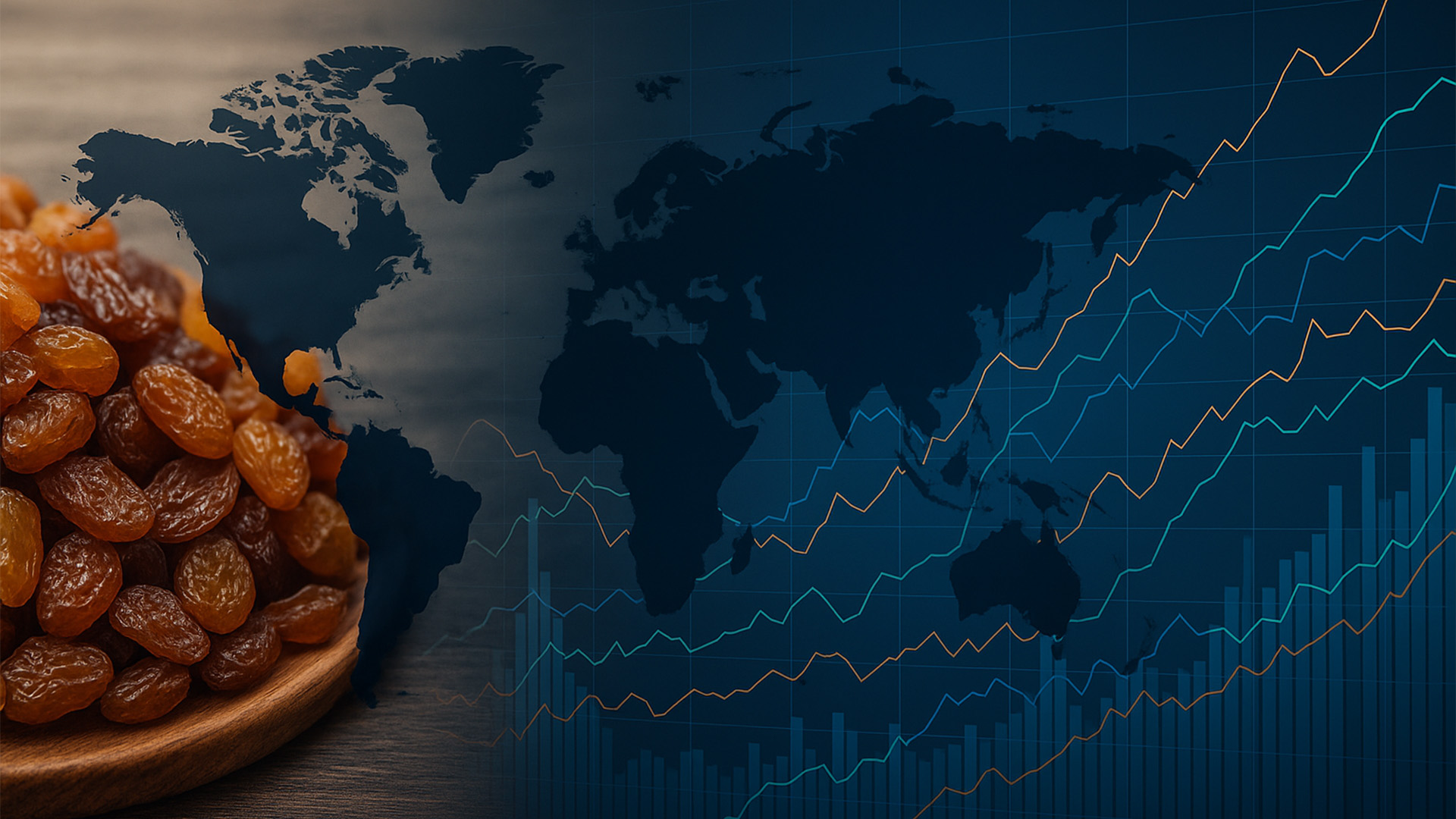Analysis of Sultana Raisin Prices with Global Context

To keep our valued partners and customers informed, Rahmani Group will begin publishing a monthly market trend analysis on our key B2B offerings, including premium products such as Pistachio Kernels, Sultana Raisins, and Golden Raisins. These analyses will provide in-depth insights into the factors shaping market dynamics, including production forecasts, demand trends, and pricing fluctuations. By delivering this timely information, Rahmani Group aims to empower businesses with the knowledge needed to make informed decisions and optimize their procurement strategies in the global market.
This analysis focuses on the factors influencing Sultana raisins prices in the coming month, with supporting data from other key Sultana raisin-producing countries. It aims to provide valuable insights for stakeholders in the Sultana raisin industry, including buyers, sellers, and those interested in the global Sultana raisin market.
Keywords: Sultana raisins, Sultana raisin prices, raisin market, Sultana raisin export, dried fruit, Rahmani Group
—————–
Factors Influencing Sultana Raisin Prices
Several factors combine to determine the price of Sultana raisins in the market:
- Domestic Production Volume: The volume of Sultana raisins produced each year is a primary driver. This, in turn, is affected by:
- Weather conditions during the growing season (frost, drought, heat waves, rainfall).
- Vineyard health and incidence of pests and diseases.
- Availability and cost of labor for harvesting and processing.
- Drying conditions during the production process.
- Global Demand: Demand for Sultana raisins in major importing markets significantly influences prices. Key markets include Europe, the Middle East, and Asia.
- Currency Exchange Rates: Fluctuations in currency exchange rates between major producing and importing countries can impact the competitiveness of Sultana raisins in the international market.
- Production Costs: The cost of inputs such as fertilizers, pesticides, water, and energy can affect the final price of Sultana raisins.
- Trade Policies and Regulations: Import/export tariffs, trade agreements, and food safety regulations can influence the flow of Sultana raisins and their prices.
- Inventory Levels: Carryover stocks from the previous season can impact the supply and price of new crop Sultana raisins.
—————–
Comparative Data from Other Countries
To provide context for Sultana raisin prices, it’s essential to consider data from other key producing regions:
- Iran: Iran is one of the world’s largest producers of Sultana raisins. Our prices are influenced by:
- Annual production volume and quality.
- Domestic and international demand.
- Government policies and support for the agricultural sector.
- Competition from other origins.
- United States (California): California is a significant producer of raisins, including Sultanas. Prices are affected by:
- Grape yield and drying conditions.
- Domestic consumption and export volumes.
- Industry standards and marketing practices.
- Turkey: Turkey is a notable producer of Sultana raisins. Their production and pricing are influenced by factors similar to those affecting Iran, including domestic conditions and export demand.
- South Africa: South Africa is an emerging player in the global raisin market.
—————–
Potential Price Trends for Sultana Raisins in the Coming Month
Considering the factors mentioned above, here are some potential price trends for Sultana raisins in the coming month:
- Scenario 1: Stable Supply and Demand: If major producing regions experience favorable conditions and global demand remains steady, Sultana raisin prices are likely to exhibit relative stability.
- Scenario 2: Supply Shortages: Adverse weather conditions or production challenges in key producing countries could lead to supply shortages and upward pressure on prices.
- Scenario 3: Increased Demand: Rising demand from specific markets or increased use of Sultana raisins in food processing could drive prices higher.
- Scenario 4: Currency Fluctuations: Significant currency fluctuations could impact the competitiveness of Sultana raisins from different origins, affecting prices in importing markets.
—————–
Conclusion
Predicting Sultana raisin prices requires a comprehensive understanding of the various factors influencing production, demand, and trade. By monitoring crop conditions in key producing regions, global market trends, and currency exchange rates, stakeholders can better anticipate price movements. As a dedicated supplier and exporter of high-quality Sultana raisins, Rahmani Group plays a crucial role in connecting global markets with premium dried fruit. With our extensive experience in the industry, we are committed to providing our customers with reliable supply, valuable market insights, and competitive prices, while adhering to the highest standards of quality and food safety.
At the moment due to weather changes (Frost and Storm) in Nowruz and past days, Iran and Turkey crop for new season has been affected. And with considering the demand and exported volume, we expect the price for next month to be stable or upward by a degree. And in case currency exchange rates stays in the same range, this estimation would be valid for May 2025.
In case you have any questions or enquiries please do not hesitate to contact us through our WhatsApp or email at export@rahmanigroup.com.
For our European friends and buyers, we have stock of Sultana Raisins inside our warehouse in Milan, Italy. Please contact us for more information.
